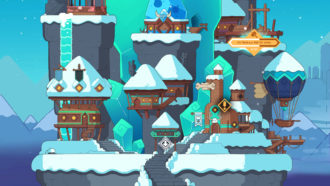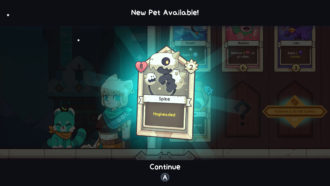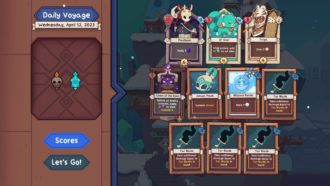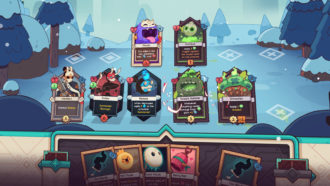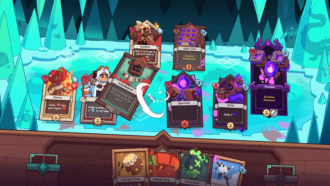Platforms:
PC, Nintendo Switch
Released:
April 12, 2023
Publisher:
Chucklefish Games
Developer:
Deadpan Games
Wildfrost is an upcoming tactical deckbuilding game developed by Deadpan Games and Gaziter and published by Chucklefish. Set in a world plagued by an eternal winter, it’s up to you to gather a band of heroes, take on enemies, and restore the balance of the world.
If you enjoy titles like Slay the Spire, Banner of Ruin, and Monster Train, the overall premise of Wildfrost will feel familiar. Much like other deckbuilding games, a game of Wildfrost will see you traversing a procedurally generated map consisting of battle, merchant, and event and treasure encounters. You’ll start with a base deck consisting of some attack and item cards and you’ll be able to collect more cards as you complete encounters, collect gold, and defeat bosses.
Card battles are turn-based and happen on a grid where your units face off against enemies in two rows. Every turn, you get one action that you can use to play a companion card – which means placing one of your units on the grid – an item card, or an attack card. While companion cards are collected along the way through encounters, you’ll always start a run with a hero character card who’ll lead your troops on their adventure. They’re the nerve centre of everything: if your hero dies on the battlefield, the game is over.
Before starting a new game, you’ll be presented with three options of starting hero. You’ll also be able to choose a pet to accompany your hero. While initially, you’ll only have a handful of pets to choose from, you’ll unlock more throughout the game. Pets’ health and abilities don’t change, but your hero’s health and attack stats are randomised, and their additional abilities will depend on what tribe they belong to. Wildfrost comes with three different tribes: the Snowdwellers, the Shademancers, and the Clunkmasters. Each one comes with unique abilities, perks, and drawbacks. The Snowdwellers deck revolves around dealing high damage and delaying enemy attacks, whereas the Shademancer deck is focused on summoning temporary allies that can aid you in battle.
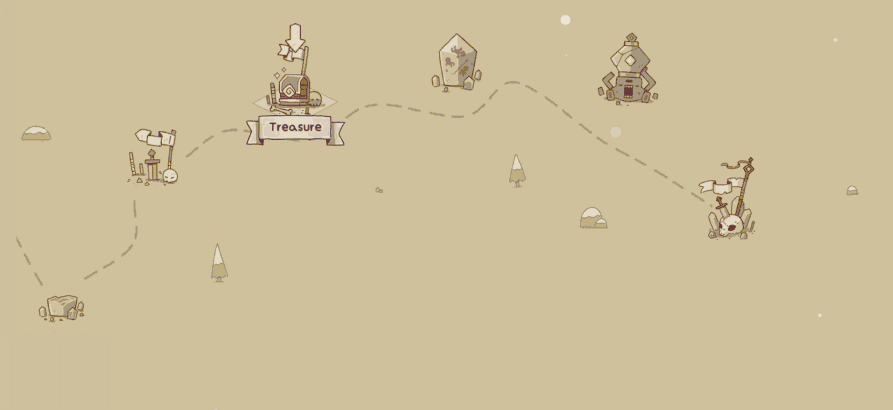
Each tribe comes with its own visual identity too, and every aspect of Wildfrost’s visuals – from item cards, to companions and backdrops – is beautifully detailed, colourful and vibrant. Combined with the game’s whimsical soundtrack, Wildfrost weaves together an in-game world that makes it easy to while away the hours run after run, whether you’re in the midst of battle or looking at a colourful menu screen.
Where Wildfrost’s core game mechanics differ from other deckbuilding games is through its dynamic counter system; each unit card comes with its own attack counter, which counts down every turn, indicating when a unit will trigger an attack. A unit with an attack counter of five, for instance, will only attack every five turns, while a unit with an attack counter of three will attack once every three turns. Other units may have special counters where they will only attack once they’ve been hit by an enemy’s attack. Some item cards can delay enemy attacks or lower the attack counter of a friendly unit, meaning they’ll attack sooner.
Drawing cards works a little differently in Wildfrost, too. Rather than drawing a new hand of cards every turn, Wildfrost comes with a ‘redraw bell’, which also has a counter of its own. At the start of a game, the redraw bell counter will count down from four. If you want to draw a new hand of cards before the redraw bell counter reaches zero, you can hit the bell and do so, but you won’t be able to perform any other actions during that turn. When the counter reaches zero, however, you’ll be able to draw a new hand of cards at no cost.
There’s also a ‘wave deployer’ visible on the battlefield. This counter shows the number of turns until the next wave of enemies appears. If the counter reaches zero, no more enemies will appear after you kill the ones currently on the battlefield, and you’ll win the battle after all enemies have been slain. In boss battles, however, the battle ends whenever the boss is killed, no matter whether there are other enemies left on the battlefield or not.
“…the dynamic attack counter system is a refreshing change that adds a healthy dose of depth and suspense to the whole gameplay experience.”
In this sense, building a strategy strongly revolves around careful planning, rather than taking things turn by turn. Many gameplay elements in Wildfrost – like the redraw bell – cater to this explicitly. Companion cards, for example, can be taken off the board at no action cost during a turn so they can be healed and shuffled back into your draw pile. However, there’s a catch: since you won’t be able to place the companion back on the board until you draw the same companion card again, you’ll have to be strategic as to how and when you do this. Keeping an eye on a companion’s card health is crucial. If a companion is downed in battle before you’ve had a chance to reshuffle them back into your deck, they’ll be injured, meaning their attack and health stats will be temporarily lower. If you manage to survive the next battle without an injured companion being downed again, they’ll be healed and back to normal. If they do perish on the battlefield, you’ll have to find a new companion to replace them.
On top of your companion’s health, you’ll also have to be mindful of status effects on the battlefield. Whether it’s poisonous shroom clouds that deal damage over time, or the ‘demonize’ effect that doubles the amount of damage a unit receives, you’ll have to keep a close eye on every unit between turns to ensure victory.
Even though all of this may sound complicated, it’s remarkably easy to wrap your head around the mechanics after a couple of runs, and the nature of each effect feels suitably complex to keep things challenging as you progress through the game. Added to this, you also have the options to collect charms as you traverse the map. Charms essentially function as one-time upgrades that can be attached to units for the duration of a run. Be careful though: once you equip a companion with a charm, you’re not able to unequip it, and, if the companion dies, the charm will be gone, too.
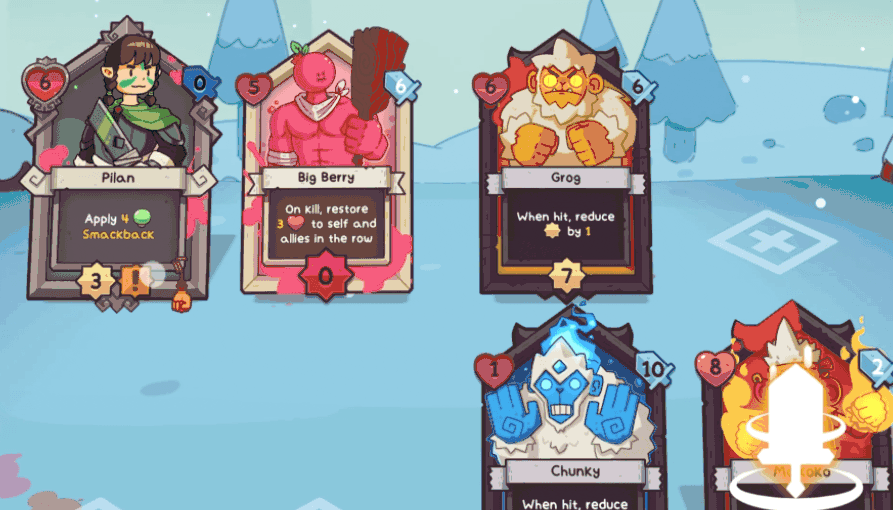
This, combined with the dynamic nature of the procedurally generated map, helps to keep you on your toes as a player, even if you’re a more seasoned deckbuilder fan. While the overall mechanics feel familiar for the deckbuilder genre, the dynamic attack counter system is a refreshing change that adds a healthy dose of depth and suspense to the whole gameplay experience. Every item, charm, or card that you pick up adds something of value to a run, and the moments of unlocking the right synergies between different cards are satisfying.
Added to this, you’ll have the opportunity to complete challenges and unlock things between runs too, as you return to the starting town of Snowdwell. Similar to the features in Darkest Dungeon and Hades, Snowdwell functions as a central hub that you return to after a run, and where you can upgrade and unlock tribes, cards, and charms before starting your next game.
You’ll also be able to access the Daily Voyage mode from Snowdell. This mode comes with a deck and a set of modifiers that change every day. You can compete for the highest daily score on a global leader board or compare your scores with your friends. All of this helps to keep things interesting once you’ve completed the main game. In this sense, everything in Wildfrost is engineered to keep challenging players through a gentle progression, keeping the gameplay from ever tipping over into frustration. The game eases you into its mechanics gradually and provides players with plenty of opportunities to try things at their own pace.
The only feature that felt like it was missing was an in-game glossary. Most players who are familiar with deckbuilder mechanics will be able to figure things out for themselves pretty quickly, but if you’re new to the genre, there may be instances where you find yourself wondering how a specific ability works turn-to-turn. Overall, however, this is hardly a drawback as the game’s design is very sleek; it’s easy to learn but hard to master, making it a good fit for both brand-new card game fans and seasoned players.
8.5
Great
Positive:
- Engaging dynamic attack counter system keeps things interesting
- Plenty of variety through companions, charms, and encounters
- Beautiful visuals and soundtrack
- Daily voyage mode and engaging challenges to complete between runs
Negative:
- No in-game glossary
Overall, Wildfrost is an incredibly well-designed gameplay experience that is sure to delight. Through its dynamic attack counter system, combined with features like charms, encounters, and randomised hero stats, the gameplay feels as dynamic and challenging on the twentieth run as it does on the very first one. No matter whether you’re a complete newbie or a card game veteran, Wildfrost is sure to entice you with its beautifully hand-drawn graphics, charming soundtrack, and engaging gameplay.
